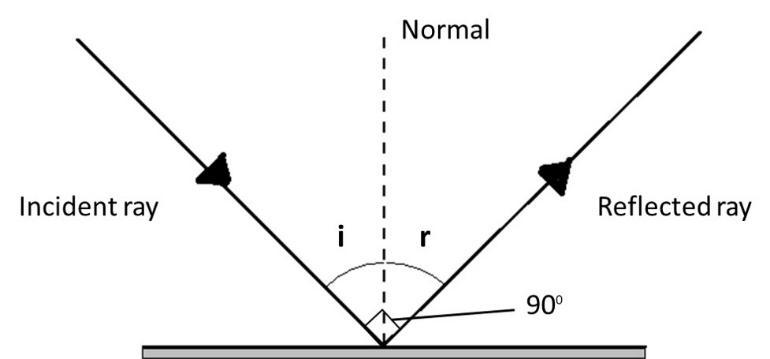
What is the angle of incidence of a ray if the reflected ray is at an angle of \[{90^{\text{o}}}\] to the incident ray?
Answer
568.2k+ views
Hint: In this question, we should learn the law of reflection. Consider the angle of incidence as \[i\] and consider the angle of reflection as \[r\]. The angle of incidence is always measured in between the incident ray and the normal ray.
Complete step by step answer
In this question, we must consider the figure (1) to show the incident ray, reflected ray and the normal at the point of incidence that lie in the same plane.
So, the incident ray of light falls on the surface and makes the angle with the normal that is \[i\], and the angle made by reflected ray with the normal is \[r\] which is normal to the bottom of the surface. We are given that the reflected ray at an angle of incidence is \[{90^{\text{o}}}\].
When the ray of light passes through and that is incident on the surface, so that ray gets reflected in a certain direction.

Figure (1)
As we know that the incident angle is the angle made by the incident ray with the normal at the point of incidence and the reflected angle is the angle made by the reflected ray with the normal at the point of incidence.
Now we use the law of reflection, this law says that incident angle is equal to the reflected angle. So,
\[ \Rightarrow \angle i = \angle r\]
Now we write the equation as per given in the question,
\[ \Rightarrow \angle i + \angle r = {90^{\text{o}}}\]
Let us assume that the angle be \[x\] and substitute in the above equation as,
\[ \Rightarrow x + x = {90^{\text{o}}}\]
After adding the values, we get,
\[ \Rightarrow 2x = {90^{\text{o}}}\]
\[\therefore x = {45^{\text{o}}}\]
Thus, the angle of incidence is \[{45^{\text{o}}}\]
Therefore, the reflected ray is at an angle of \[{90^{\text{o}}}\] to the incident ray , then the angle of incidence is \[{45^{\text{o}}}\].
Note
As we know that the angle of incidence is equal to the angle of reflection, \[\angle i = \angle r\], and the reflected ray and incident ray and the normal at the point of incidence all these lie on the same plane.
Complete step by step answer
In this question, we must consider the figure (1) to show the incident ray, reflected ray and the normal at the point of incidence that lie in the same plane.
So, the incident ray of light falls on the surface and makes the angle with the normal that is \[i\], and the angle made by reflected ray with the normal is \[r\] which is normal to the bottom of the surface. We are given that the reflected ray at an angle of incidence is \[{90^{\text{o}}}\].
When the ray of light passes through and that is incident on the surface, so that ray gets reflected in a certain direction.

Figure (1)
As we know that the incident angle is the angle made by the incident ray with the normal at the point of incidence and the reflected angle is the angle made by the reflected ray with the normal at the point of incidence.
Now we use the law of reflection, this law says that incident angle is equal to the reflected angle. So,
\[ \Rightarrow \angle i = \angle r\]
Now we write the equation as per given in the question,
\[ \Rightarrow \angle i + \angle r = {90^{\text{o}}}\]
Let us assume that the angle be \[x\] and substitute in the above equation as,
\[ \Rightarrow x + x = {90^{\text{o}}}\]
After adding the values, we get,
\[ \Rightarrow 2x = {90^{\text{o}}}\]
\[\therefore x = {45^{\text{o}}}\]
Thus, the angle of incidence is \[{45^{\text{o}}}\]
Therefore, the reflected ray is at an angle of \[{90^{\text{o}}}\] to the incident ray , then the angle of incidence is \[{45^{\text{o}}}\].
Note
As we know that the angle of incidence is equal to the angle of reflection, \[\angle i = \angle r\], and the reflected ray and incident ray and the normal at the point of incidence all these lie on the same plane.
Recently Updated Pages
Master Class 12 English: Engaging Questions & Answers for Success

Master Class 12 Economics: Engaging Questions & Answers for Success

Master Class 12 Social Science: Engaging Questions & Answers for Success

Master Class 12 Maths: Engaging Questions & Answers for Success

Master Class 12 Chemistry: Engaging Questions & Answers for Success

Master Class 12 Business Studies: Engaging Questions & Answers for Success

Trending doubts
What are the major means of transport Explain each class 12 social science CBSE

Which are the Top 10 Largest Countries of the World?

Draw a labelled sketch of the human eye class 12 physics CBSE

Explain sex determination in humans with line diag class 12 biology CBSE

The pH of the pancreatic juice is A 64 B 86 C 120 D class 12 biology CBSE

Explain sex determination in humans with the help of class 12 biology CBSE




